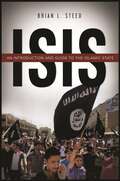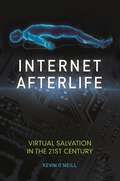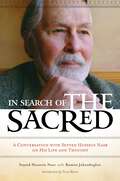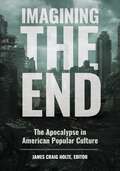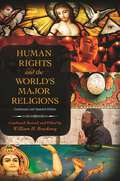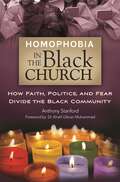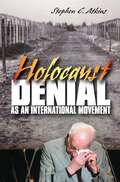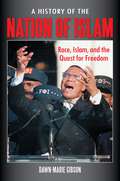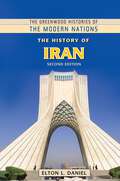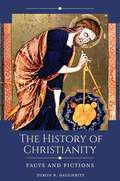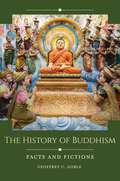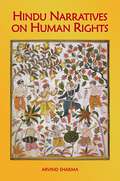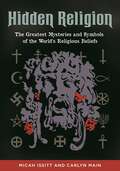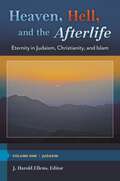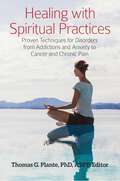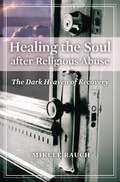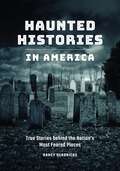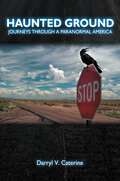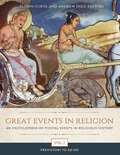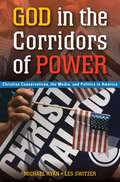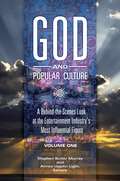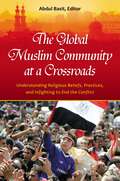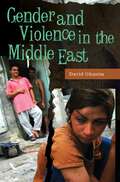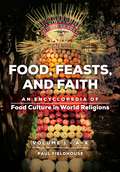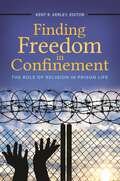- Table View
- List View
ISIS: An Introduction and Guide to the Islamic State
by Brian L. SteedProviding up-to-date information for general readers as well as those well-informed about the Islamic State, this book offers an essential understanding of the rise of ISIS and its current influence in the Middle East as well as worldwide.ISIS—also referred to as ISIL, the Islamic State, or Daesh—began to assert its power and gain recognition for its militant and terroristic activities in April 2013. After the coordinated attacks in Paris on November 13th, 2015, ISIS has captured the full attention of observers in the West. This accessible book explains what ISIS is, what the group's goals are, what their members believe, and why their ranks are growing. Readers will gain an understanding of how ISIS is a unique group—one seeking to be the army of the righteous fighting to defeat the unbelievers and usher in the end of days—but that the extremist views of ISIS are an expression of a growing frustration with life in the Middle East and elsewhere shared by a larger community of non-state and post-state actors.The book provides an introduction that documents the origins of ISIS within the larger Al Qaeda organization during the Iraq War. The following chapters discuss the origins, development, and territorial expansion of ISIS in Syria and Iraq and examine the ideological motivations behind the emergence of ISIS, thereby enabling a nuanced understanding of the importance of ISIS in contemporary history. Other entries discuss individuals, events, and organizations that put ISIS in historical context in terms of contemporary events since the Iraq War into the present and explain the group's position within the complex conflict currently boiling in the Middle East.
Internet Afterlife: Virtual Salvation in the 21st Century
by Kevin O'NeillCan you imagine swapping your body for a virtual version? This technology-based look at the afterlife chronicles America's fascination with death and reveals how digital immortality may become a reality.The Internet has reinvented the paradigm of life and death: social media enables a discourse with loved ones long after their deaths, while gaming sites provide opportunities for multiple lives and life forms. In this thought-provoking work, author Kevin O'Neill examines America's concept of afterlife—as imagined in cyberspace—and considers how technologies designed to emulate immortality present serious challenges to our ideas about human identity and to our religious beliefs about heaven and hell.The first part of the work—covering the period between 1840 and 1860—addresses post-mortem photography, cemetery design, and spiritualism. The second section discusses Internet afterlife, including online memorials and cemeteries; social media legacy pages; and sites that curate passwords, bequests, and final requests. The work concludes with chapters on the transhumanist movement, the philosophical and religious debates about Internet immortality, and the study of technologies attempting to extend life long after the human form ceases.
In Search of the Sacred: A Conversation with Seyyed Hossein Nasr on His Life and Thought
by Seyyed Hossein Nasr Professor Ramin JahanbeglooIn this book, a series of interviews offers an accessible, revealing, human and intellectual biography of leading Islamic scholar Seyyed Hossein Nasr.Seyyed Hossein Nasr is one of the preeminent philosophers writing today. Sure to be a key resource for decades to come, In Search of the Sacred: A Conversation with Seyyed Hossein Nasr on His Life and Thought illuminates Nasr's experiences and shares his insights on topics from religion and philosophy to science and the arts.Based on a series of interviews, the book combines traditional autobiography with an exploration of the intellectual and spiritual trajectories of the author's thought during key periods of his life. In doing so, it presents a fascinating panorama, not only of the life and ideas of one man, but also of major events ranging from intellectual life in Iran during the Pahlavi period and the Iranian Revolution to some of the major religious and intellectual debates between Islam and modernism. Nasr writes that his "whole life has been a quest for the sacred." This work connects that quest with some of the most important issues of the day in encounters between Islam and the West.
Imagining the End: The Apocalypse in American Popular Culture
by James Craig HolteImagining the End provides students and general readers with contextualized examples of how the apocalypse has been imagined across all mediums of American popular culture. Detailed entries analyze the development, influence, and enjoyment of end-times narratives.Imagining the End provides a contextual overview and individual description and analysis of the wide range of depictions of the end of the world that have appeared in American popular culture. American writers, filmmakers, television producers, and game developers inundated the culture with hundreds of imagined apocalyptic scenarios, influenced by the Biblical Book of Revelation, the advent of the end of the second millennium (2000 CE), or predictions of catastrophic events such as nuclear war, climate change, and the spread of AIDS. From being "raptured" to surviving the zombie apocalypse, readers and viewers have been left with an almost endless sequence of disasters to experience. Imagining the End examines this phenomenon and provides a context for understanding, and perhaps appreciating, the end of the world. This title is composed of alphabetized entries covering all topics related to the end times, covering popular culture mediums such as comic books, literature, films, and music.
Human Rights and the World's Major Religions: Condensed And Updated Edition
by William H. BrackneyBased on the celebrated five-volume set published in 2005, this updated one-volume edition offers readers a concise yet complete understanding of the interplay between the major religions and human rights.In a world where religious beliefs have become inseparable from the events of the day, ranging from the ongoing strife in the Middle East to cases of sexual abuse by clergy and controversy over circumcision laws in Europe, this is an invaluable work. It offers readers a comprehensive examination of the way the world's five major faiths—Judaism, Christianity, Islam, Hinduism, and Buddhism—view and have viewed human rights from ancient times to the present. An overview of each tradition is provided, followed by chapters that show how human rights have been shaped and understood in the tradition from the earliest textual evidence to the contemporary era.Considering the differences among religious traditions globally, the book shows how each faith advanced the cause of human rights in unique ways. Contributors track the development of ideas, opinions, and issues, documenting both the advancement and violation of human rights in the name of religion. Demonstrating that human rights discourse cannot be divorced from religious history and experience, the book covers such issues as the right to life, the rights of women, punishment for crimes, war and peace, slavery, and violence.
Homophobia in the Black Church: How Faith, Politics, and Fear Divide the Black Community
by Anthony StanfordThis book explains how faith, politics, and fear contribute to the homophobic mindset within the Black Church and the African American community.Homophobia in the Black Church: How Faith, Politics, and Fear Divide the Black Community explores the various reasons for the Black Church's aversion—and the general black cultural inflexibility—toward homosexuality, same-sex marriage, and acceptance of the LGBT community. It connects black cultural resistance toward homosexuality to politics, faith, and fear; follows the trail of faith-based funding to the pulpit of black mega-churches; and spotlights how members of the black clergy have sacrificed black LGBTQ Christians for personal and political advancement.The author systematically builds his case, linking the reasons blacks are intolerant of deviation from acceptable sexual behavior to the 1960s struggle for racial equality, and tying longstanding black sexual mores to present day politics, social conservatism, and the lure of federal funding to black churches and religious and social organizations. He also spotlights specific homophobic black ministers and draws back the curtain on their alliance with White social conservatives and religious and political extremists to reveal an improbable but powerful union.
Holocaust Denial as an International Movement
by Stephen E. AtkinsThe end of World War II saw an emergence of Holocaust dissention that began in Europe and has since developed into an international movement with adherents in almost every country in the world. At first, this denial was fueled by the desire to rehabilitate Adolf Hitler and the Nazi regime in an effort to reestablish a neo-Nazi state. In the following years, coupled with the renewal of anti-Semitism, this dissent has been used as a means of denying the legitimacy of the state of Israel. Despite these motivations, the ultimate cause for concern is in the way this denial attracts its members by both challenging the existence of the Holocaust and the testimony of its witnesses. By tracing the history, causes, and spread of Holocaust denial, Atkins reveals the dangers this mindset poses to rational thinkers who become vulnerable to fringe ideas.This book traces the state of the international Holocaust denial movement in the early 21st century, grounding contemporary thought in the history of the movement. Since Holocaust deniers have distorted the facts about this mass genocide, Atkins discusses just what is known about the Holocaust from historical research conducted since World War II. The role of negative racial genetics is explored in both Hitler's intellectual makeup and among the leaders of the German right wing, including historians' assessments of Hitler's anti-Semitism, motivations, and decision-making. Also provided is a roll call of Holocaust dissenters in countries such as the United States, Germany, France, Great Britain, Russia, and Italy, among many others. By analyzing the arguments of leaders within this expanding dissention movement, this book demonstrates how extremists build informational links that have wide-ranging effects.
A History of the Nation of Islam: Race, Islam, and the Quest for Freedom
by Dawn-Marie GibsonThis book provides a fascinating, unparalleled look at the Nation of Islam, including its history, the complexity of its views towards orthodox Muslims, women, and other minorities, and the trajectory of the group after the 1995 Million Man March.The release of the Federal Bureau of Investigation's extensive archive of surveillance files, interviews, and firsthand accounts has made it possible to reveal the truth behind the myths and misperceptions about the Nation of Islam. This comprehensive resource catalogues the times, places, and people that shaped the philosophies from its formative years through to its present incarnation.The definitive source on the subject, A History of The Nation of Islam: Race, Islam, and the Quest for Freedom draws on over a dozen interviews, along with archival and rarely-used sources. The book departs from the usual "Malcolm X-centric" treatment of the subject, and instead examines the early leadership of Fard Muhammad, challenges conventional views on Malcolm X, and explores the present day internal politics of the movement post Louis Farrakhan's retirement.
The History of Iran (The Greenwood Histories of the Modern Nations)
by Elton L. DanielThis comprehensive survey of Iran's historical development covers everything from its origins in ancient empires to its status as a modern nation-state.Iran is a vast country with a storied, ancient past, a great diversity of cultures and ethnicities, and a location in arguably the most unstable area of the world. Iran's history over the last two centuries—developing as a modern nation-state, freeing itself from foreign domination, and asserting its influence in both the region and the world—has been particularly fascinating.This title gives an overview of Iranian history written for a general audience. It is intended to acquaint readers with the important events and personalities that have shaped that long history. In this second edition of The History of Iran, the author has thoroughly revised the original content and has added two new chapters, one of which is dedicated to Iran in the 21st century. Particular attention is paid to explaining the forces that led to the revolution of 1979 and the establishment of the Islamic Republic of Iran, as well as the controversies of its domestic and foreign policies.
The History of Christianity: Facts and Fictions (Historical Facts and Fictions)
by Dyron B. DaughrityChristianity has been accused of being misogynistic, pro-slavery, and anti-science, and some say it is finally beginning its long decline. This book provides an entirely different side to the stories about this faith.Why did Christianity become the largest religion in the world? Is it because it was misogynistic, pro-slavery, anti-science, and set on condemning those who didn't join it? This book investigates many of the misconceptions about Christianity and argues that there are good reasons this faith has become the world's largest.The book includes chapters on various misconceptions related to the history of Christianity, such as the beliefs that Jesus was a meek and mild carpenter, the Roman emperor Constantine was insincere in his Christian faith, medieval Europe was devoutly Christian, and Christianity was anti-science. Each chapter explores how the historical misconception developed and spread, and offers what we now believe to be the historical truth contradicting the fiction. Excerpts from primary source documents provide evidence for the historical misconceptions and truths and help readers to respond critically to claims about Christian history.
The History of Buddhism: Facts and Fictions (Historical Facts and Fictions)
by Geoffrey C. GobleOne of the world's most popular religions, Buddhism is also one of the most misunderstood. This reference overviews misconceptions related to Buddhism and reveals the truths behind the myths.Buddhism is practiced by millions of adherents around the world. Originating in ancient India, it spread throughout Asia and then to the West, and it exists in multiple traditions. Despite its popularity, it is also the subject of many misconceptions. This book examines those misconceptions along with the historical truths behind the myths.The book begins with an introduction that places Buddhism in its historical and cultural contexts. This is followed by chapters on particular erroneous beliefs related to the religion. Chapters explore whether Buddhism is a singular tradition, if it is a religion or a philosophical system, if it is rational and scientific, whether the Buddha was an ordinary human, and other topics. Each chapter summarizes the misconception and how it spread, along with what we now believe to be the underlying truth behind the falsehood. Quotations and excerpts from primary source documents provide evidence for the mistaken beliefs and the historical truths. The book closes with a selected, general bibliography.
Hindu Narratives on Human Rights
by Arvind SharmaThis pioneering work examines the existing understanding of Hinduism in relation to human rights discourse.Written by a leading Hindu scholar, Hindu Narratives on Human Rights is organized around specific rights, such as the right to own property, the rights of children, women's rights, and animal rights. Within these categories and in light of the questions they raise, the book provides a guided tour of Hindu narratives on ethics, ranging from the famous religious epics, the Mahabharata and the Ramayana, to various forms of secular literature drawn from almost a thousand years of Indic civilization. The realization that Hindu ethical discourse is narrative rather than propositional is a relatively recent one. Hence, the prevailing tendency in the West has been to overlook it in the context of the discussion of human rights. This book was written to correct that oversight. It shows that the presence of the universal in the particular in Hindu stories is a key to understanding Hindu thinking about human rights—and it indicates ways in which Hindu ethical discourse can interact creatively with modern human rights discourse.
Hidden Religion: The Greatest Mysteries and Symbols of the World's Religious Beliefs
by Micah Issitt Carlyn MainCovering secret societies, mysterious ancient traditions, and the often-mistaken history of the world's religious symbols, this book takes readers on a tour through the fascinating world of religious symbolism and reveals the most mysterious and misunderstood facets of religion.Hidden Religion: The Greatest Mysteries and Symbols of the World's Religious Beliefs not only explores the history and origins of widely recognizable symbols, like the Christian cross and the Star of David, but also introduces readers to more obscure symbols from religious traditions around the world—even defunct ones like those of the ancient Aztec and Mayan societies. In addition, the book discusses the "religious secrets" found in the major religions, including secret societies of Christianity, Judaism, Islam, and Buddhism.Containing more than 170 entries, the encyclopedia is organized by religious category, such as Abrahamic, East Asian, and African Diasporic religions, then alphabetically within each category. Each entry is prefaced with a short introduction that explains where and when the religious tradition originated and describes the religion today. This information is followed by an analysis of the historical development and use of symbols along with an explanation of connections between symbols used by different religions, such as shared astrological symbolism in the form of moon, sun, or star motifs.
Heaven, Hell, and the Afterlife [3 volumes]: Eternity in Judaism, Christianity, and Islam [3 volumes] (Psychology, Religion, and Spirituality)
by J. Harold EllensChristianity, Islam, and Judaism all feature ideas about heaven, hell, and afterlife, and these concepts have evolved over time within these religions. This work supplies a detailed and coherent understanding of the broad scope of spiritual thinking in the last 3,000 years within the Abrahamic traditions. Heaven, Hell, and the Afterlife: Eternity in Judaism, Christianity, and Islam provides an all-encompassing examination of historic and contemporary perspectives on afterlife in Western religions. In these three volumes, Judaic, Christian, and Muslim scholars join forces, providing an unprecedented review of their individual faith's traditions. Every significant issue and major theme is discussed; no controversial topic is avoided. From ancient doctrines to modern-day outlooks of conservatives, progressives, and liberals in all three religions, all are analyzed and presented here.The framework of the volumes underscores how the ethics and concepts of eternity in the Western "action" religions contrast with Eastern religions that tend to be characterized as "passive" or "withdrawal" religions in their ethics and their notions of afterlife as absorption within universal spirit, Nirvana, or nonexistence. This work is well-suited for undergraduate and graduate students, general readers interested in religion, and professional scholars, particularly those in fields corollary to religious study.
Healing with Spiritual Practices: Proven Techniques for Disorders from Addictions and Anxiety to Cancer and Chronic Pain
by Thomas G. PlanteThis interdisciplinary study details spiritual approaches including meditation and yoga shown to be helpful in improving physical and psychological well-being.Whether a person suffers from a psychological or physical malady, such as depression, addictions, chronic pain, cancer, or complications from pregnancy, the best practice treatments likely include one common thread: spiritual practice. From meditation and yoga to spiritual surrender and religious rituals, spiritual practices are increasingly being recognized as physically and mentally beneficial for recovering from illness and for retaining optimal health. Healing with Spiritual Practices: Proven Techniques for Disorders from Addictions and Anxiety to Cancer and Chronic Pain, edited by the director of one of the nation's best-known university institutes of spirituality and health, explains current and emerging practices, their benefits, and the growing body of research that proves them effective. Comprising chapters from expert contributors, this book will appeal to students, scholars, and other readers interested in psychology, medicine, nursing, social work, pastoral care, and related disciplines.
Healing the Soul after Religious Abuse: The Dark Heaven of Recovery (Religion, Health, and Healing)
by Mikele RauchRecent scandals of clergy sexual abuse have brought attention to the victims and their responses to and recovery from their abuse. But few have considered the effect of the abuse on a victim's soul and religious outlook and beliefs. Healing the Soul after Religious Abuse, offers a unique perspective of recovery and restoration of the soul after religious abuse. The author argues that religious abuse often stops not only psychological growth, but also inward development. The effect is not simply emotional, because the devastation reaches to the core of the spirit. Often there is no place for a God of love or a love of what once was divine. Through a series of personal interviews with persons from the five major religions, Rauch considers various ways that religion can do harm.The stories told in this book include the road to restoration in the wake of institutional abuse and how inner experience is sometimes confused with religious training; the sacred task of spiritual leadership and how to restore trust when there has been a violation; an exploration of sacrifice and a clarification of the notion of shame; a look at the impact of religious bigotry in the areas of race, sexuality, and tolerance; an overview of sexuality and the place it holds in both celibate and family life; the pernicious issue of clergy sexual abuse and the signs of spiritual trauma in response to such violation; a roadmap for restoration and a challenge to religious institutions; and, lastly, ways to reclaim the sacred and rewire the spirit. Through interviews, research, and personal stories, the author tells a story of recovery of the most delicate kind, offering pathways through the dark night of religious violation to a restoration of the soul and its immense possibilities.
Haunted Histories in America: True Stories behind the Nation's Most Feared Places
by Nancy HendricksIf you believe in ghosts, you're in good company. Haunted Histories brings America's most ghostly locales to life, illuminating their role in shaping U.S. history and detailing how they became the nation's most feared places.Haunted Histories takes readers on a state-by-state journey across the United States, exploring the nation's most feared places. Along the way, the text introduces readers to new ghostly tales and takes a fresh look at familiar stories and locations, with an eye to history. From well-known spooky spots like Salem, Massachusetts, to such lesser-known ones as the Shanghai Tunnels of Portland, Oregon, where spirits are supposedly trapped, readers will discover not only where America's most haunted places are but also why they are said to be haunted. The ghosts of the doomed Donner Party allow readers to experience the arduous and often deadly journey of America's westward wagon trains, while different kinds of "spirits" haunting old distilleries allow readers to discover how whiskey almost derailed the new American nation before it was born.This book can be studied for academic purposes as a historical reference, used as a source for classroom assignments, or simply read for the pleasure of a great story.
Haunted Ground: Journeys through a Paranormal America
by Darryl V. CaterineThis fascinating and insightful tour through present-day meetings of Spiritualists, UFOlogists, and dowsers illuminates our obsession with the paranormal and challenges the misunderstanding of the paranormal as a marginal or inconsequential feature of America's religious landscape.According to a 2005 Gallup poll, 75 percent of Americans believe in some form of paranormal activity. The United States has had a collective fascination with the paranormal since the mid-1800s, and it remains an integral part of our culture. Haunted Ground: Journeys through a Paranormal America examines three of the most vibrant paranormal gatherings in the United States—Lily Dale, a Spiritualist summer camp; the Roswell UFO Festival; and the American Society of Dowsers' annual convention of "water witches"—to explore and explain the reasons for our obsession with the paranormal.Both academically informed and thoroughly entertaining, this book takes readers on a "road trip" through our nation, guided by professor of American religion Darryl V. Caterine, PhD. The author interprets seemingly unrelated case studies of phantasmagoria collectively as an integral part of the modern discourse about "nature" as ultimate reality. Along the way, Dr. Caterine reveals how Americans' interest in the paranormal is rooted in their anxieties about cultural, political, and economic instability—and in a historic sense of alienation and homelessness.
Great Events in Religion [3 volumes]: An Encyclopedia of Pivotal Events in Religious History [3 volumes]
by Florin Curta and Andrew HoltThis three-volume set presents fundamental information about the most important events in world religious history as well as substantive discussions of their significance and impact.This work offers readers a broad and thorough look at the greatest events in world religious history, covering a wide range of religions, time periods, and areas around the globe. The entries present authoritative information and informed viewpoints written by expert contributors that enable readers to easily learn about the chief events in religious history, help them to better understand the course of world history, and promote a greater respect for culturally diverse religious traditions. The first of the three volumes covers religion from the preliterary world through around AD 600; the second, the post-classical era from 600 to 1450; and the third, the modern era from 1450 to the present. Each volume begins with a substantive introduction that discusses the history of world religions during the period covered by the volume. The chronologically ordered entries overview each event, place it in historical context, and identify the reasons for its enduring significance.
God in the Corridors of Power: Christian Conservatives, the Media, and Politics in America
by Michael Ryan Les SwitzerGod in the Corridors of Power: Christian Conservatives, the Media, and Politics in America is a comprehensive study of Christian conservative power in America's political culture—how it was achieved, how it is maintained, and where it is going. It came about in part because of an enduring influence in the school room, the seminary and in the pulpit, and in part because conservatives are so skilled at using commercial and non-commercial media, including religious media, to disseminate their views to broader audiences. Though their power has waxed and waned, they continue to be a potent force in public policy today.The authors argue that the astonishing electoral successes of Christian conservatives at all levels of national, state and local government was made possible by linking political, social, media and religious interests with an emerging consensus about what constitutes a conservative mindset in American politics. Christian conservatives unquestionably have been the most significant component in a coalition of religious conservatives, traditionalist conservatives and neoconservatives that has driven the Republican Party now for almost two generations.This multifaceted understanding of Christian conservative activists in religion and politics traces the impact Christian conservatives have had on American Christianity as a whole while also examining the limitations imposed on the Christian conservative agenda by American civil religion, the Constitution and case law. The authors explore women's reproductive rights in the debate over contraception and abortion, and gay civil rights in the debate over gay marriage and family rights. The debate over intelligent design and evolution is examined in the context of the campaign to transform public school education. The run-up to the wars in Afghanistan and Iraq is scrutinized against the background of the declared "war on terrorism."While the conservative religious and secular coalition within the Republican Party began to fragment even before the end of George W. Bush's first term in office, it remained a powerful force in the 2004 and 2008 elections. The book concludes with some thoughts about the impact of Christian conservatives in politics, media and religion in the future.
God and Popular Culture [2 volumes]: A Behind-the-Scenes Look at the Entertainment Industry's Most Influential Figure [2 volumes]
by Stephen Butler Murray and Aimée Upjohn LightThis contributed two-volume work tackles a fascinating topic: how and why God plays a central role in the modern world and profoundly influences politics, art, culture, and our moral reflection—even for nonbelievers.God—in the many ways that people around the globe conceptualize Him, Her, or It—is one of the most powerful, divisive, unifying, and creative elements of human culture. The two volumes of God and Popular Culture: A Behind-the-Scenes Look at the Entertainment Industry's Most Influential Figure provide readers with a balanced and accessible analysis of this fascinating topic that allows anyone who appreciates any art, music, television, film, and other forms of entertainment to have a new perspective on a favorite song or movie. Written by a collective of both believers and nonbelievers, the essays enable both nonreligious individuals and those who are spiritually guided to consider how culture approaches and has appropriated God to reveal truths about humanity and society. The book discusses the intersections of God with film, television, sports, politics, commerce, and popular culture, thereby documenting how the ongoing messages and conversations about God that occur among the general population also occur within the context of the entertainment that we as members of society consume—often without our recognition of the discussion.
The Global Muslim Community at a Crossroads: Understanding Religious Beliefs, Practices, and Infighting to End the Conflict (Practical and Applied Psychology)
by Abdul Basit Ph.D.Tackling a subject that is as timely as it is complex, this expert work examines the turmoil inside Muslim communities, helping outsiders to understand and insiders to examine ways in which Islam can be reinterpreted for a modern world.The Global Muslim Community at a Crossroads: Understanding Religious Beliefs, Practices, and Infighting to End the Conflict is an illuminating work. Written by an eminent psychologist who was raised as a Muslim in India and now resides in the United States, it examines the core reasons for the current state of affairs in Muslim communities, explaining the psychological underpinnings of Muslim religion and practices and the reasons they can fuel violence. Drawing on the editor's exposure to Eastern and Western cultures and his longstanding interest in the study of comparative world religions, this impartial analysis takes a multidimensional approach to explaining the current plight of Muslim countries. It candidly discusses issues such as the influence of Islamic schools, the negative and positive roles of Ulema (religious scholars), a lack of critical inquiry into religious thought, Sharia, and the status of women in Islam. Finally, there are positive suggestions about a road to recovery, explaining how Muslim communities can address the interlocking problems they face while retaining the positive aspects of their beliefs.
Gender and Violence in the Middle East
by David Ghanim Ph.D.Gender and Violence in the Middle East argues that violence is fundamental to the functioning of the patriarchal gender structure that governs daily life in Middle Eastern societies. Ghanim contends that the inherent violence of gender relations in the Middle East feeds the authoritarianism and political violence that plague public life in the region. In this societal sense, men as well as women may be said to be victims of the structural violence inherent in Middle Eastern gender relations. The author shows that the varieties of physical violence against women for which the Middle East is notorious—honor killings, obligatory beatings, female genital mutilation—are merely eruptions of an ethos of psychological violence and the threat of physical violence that pervades gender relations in the Middle East.Ghanim documents and analyzes the complementary roles of both sexes in sustaining the system of violence and oppressive control that regulates gender relations in Middle Eastern societies. He reveals that women are not only victims of violence but welcome the opportunity to become perpetrators of violence in the married female life cycle of subordination followed by domination. The mother-in-law plays a crucial role in supporting the structure of patriarchal control by stoking tensions with her daughter-in-law and provoking her son to commit sanctioned violence on his wife. The author applies his deep analysis of gender and violence in the Middle East to illuminate the motivational profiles of male and female political suicidalists from the Middle East and the martyrological adulation that they are accorded in Middle Eastern societies.
Food, Feasts, and Faith [2 volumes]: An Encyclopedia of Food Culture in World Religions [2 volumes]
by Paul FieldhouseAn indispensable resource for exploring food and faith, this two-volume set offers information on food-related religious beliefs, customs, and practices from around the world.Why do Catholics eat fish on Fridays? Why are there retirement homes for aged cows in India? What culture holds ceremonies to welcome the first salmon? More than five billion people worldwide claim a religious identity that shapes the way they think about themselves, how they act, and what they eat. Food, Feasts, and Faith: An Encyclopedia of Food Culture in World Religions explores how the food we eat every day often serves purposes other than to keep us healthy and stay alive: we eat to express our faith and to adhere to ethnic or cultural traditions that are part of who we are. This book provides readers with an understanding of the rich world of food and faith. It contains more than 200 alphabetically arranged entries that describe the beliefs and customs of well-established major world religions and sects as well as those of smaller faith communities and new religious movements. The entries cover topics such as religious food rules, religious festivals and symbolic foods, and vegetarianism and veganism, as well as general themes such as rites of passage, social justice, hospitality, and compassion.Each entry on religion explains what the religious dietary laws and guidelines are and how these were interpreted and put into practice historically and in modern settings. The coverage also includes important festivals and feast days as well as significant religious figures and organizations. Additionally, some 160 sidebars provide examples and more detailed information as well as fun facts.
Finding Freedom in Confinement: The Role of Religion in Prison Life
by Kent R. Kerley, EditorWhat is the nature and impact of faith and religion in prison? This book summarizes contemporary and cutting-edge research on religion in correctional contexts, enabling a scientific understanding of how prisoners use faith in their everyday lives.Religion long has been a tool for correctional treatment. In the United States, religion was the primary treatment modality in the first prisons. Only since the 1980s, however, have social scientists begun to study the nature, extent, practice, and impact of faith and faith-based prison programs. Bringing together the knowledge of scholars from around the world, this single-volume book offers readers a science- and research-based understanding of how prisoners use faith in everyday life, examining the role of religion in prison/correctional contexts from a variety of interdisciplinary and international viewpoints.By considering the perspectives of professionals actually working in corrections or prison settings as well as those of scholars studying religion and/or criminal justice, readers of Finding Freedom in Confinement: The Role of Religion in Prison Life can gain insight into the most contemporary research on religion in correctional contexts. The book contains data-driven, conceptual, and policy-oriented essays that cover major religions such as Christianity, Judaism, and Islam within correctional environments. It also addresses subject matter such as the roles of prison chaplains and correctional officers and the relationships between religion and common aspects of prison life, such as drug abuse, gangs, violence, prisoner identity, rights of prisoners, and rehabilitation.
